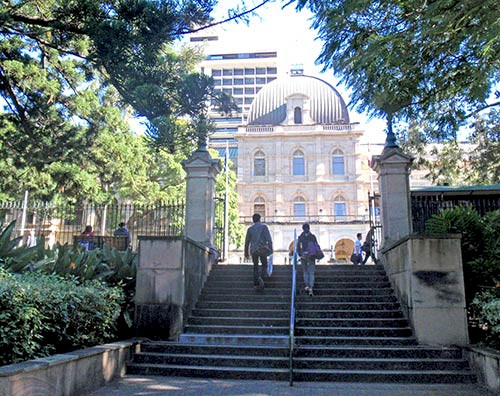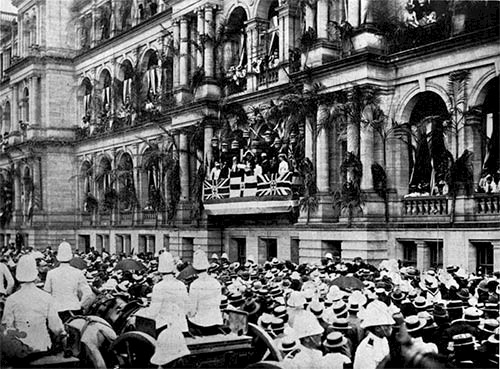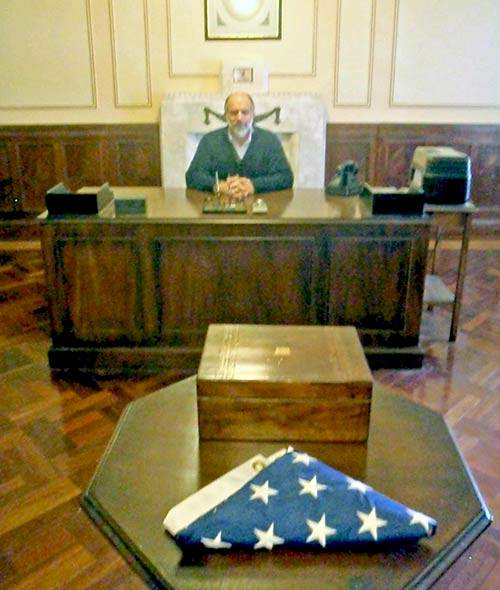Walking tour of Brisbane (Part 3): Parliament, World War II and beyond
Bill Dennison ·Walking along the front of the Queensland University of Technology (QUT) buildings with the Botanic Gardens on the right, you pass some massive banyan trees, which is an Indian fig tree named for the Bania merchants who would meet between the buttress roots. Just at the entrance to the Botanic Gardens is Parliament House, seat of the Queensland government. Construction started on Parliament House in 1864. It is open to the public for guided tours, which includes both the upper and lower house chambers. However, Queensland is the only state to now have only one chamber, having abolished the upper house in 1922, so the upper chamber is not actively used for parliamentary debate. The tall Annex is behind Parliament House, which is essentially a hotel for the 89 Members of Parliament who visit during session. There are portraits, historic photographs, and beautiful wooden carvings to see in Parliament House.

Across the street from Parliament House, is the Queensland Club in a stately old building, constructed in 1884. It was and still is an exclusive gentlemen's club. Walking along George Street (the East-West streets in Brisbane are named for kings and the North-South streets are named for queens), there are some historic buildings on the left, the executive offices for Queensland government, including the Premier, at 100 George Street. Further along is Queen's Park with a statue of Queen Victoria. There are two old historic buildings at this site, with the casino owning both buildings. Both buildings were at one time where the Queensland Premier and Cabinet had offices. The smaller building was the Lands Administration Building, and also was called the Executive Building. The larger building is the old Treasury Building, built between 1886-1928. It was the site where Governor Lamington read the Proclamation of the Federation of Australia on January 1, 1901 (marking the birth of the nation). It is worth a look inside, if you are dressed well enough and do not have children along. They made the central courtyard an atrium and retained all of the outside character of the building and some of the interior as well.

The front of the casino is the top of the Queen Street Mall, which is a very busy outdoor pedestrian mall. Walking down through the mall at the bottom, there is a historic building which houses the MacArthur Museum, commemorating the two plus years that the Supreme Allied Commander of the South West Pacific, General Douglas MacArthur was based there after being chased out of the Philippines ("I shall return" is what MacArthur said when he escaped to Australia).

MacArthur lived at the Lennon's Hotel, which was located on George Street, between Ann and Adelaide Streets. The building was torn down, and the walk-in cold room was seconded by two Professors of the Botany Department, University of Queensland. When Professors Trevor Clifford and Ray Specht told me that story, and mentioned that General MacArthur kept his beer in that cold room, I promptly went out and bought a carton of beer. I stored the beer in the cold room, figuring that it was an important American tradition to have a stash of cold beer in Brisbane. The new location of Lennon's Hotel, just off Queen Street Mall used to have MacArthur's Bar in honor of his stay.
Things were not always amicable with the Americans in Brisbane. The Brisbane saying was that the American soldiers were "Overpaid, oversexed and over here". One summer evening in late 1942, after too much drinking, a fight broke out between Australian and American soldiers in downtown Brisbane, called the 'Battle of Brisbane'. One Aussie soldier died and many Australian and American soldiers were injured.
Extending the tour beyond the central business district would take you over to South Bank via the pedestrian Goodwill Bridge, the Victoria Bridge, the pedestrian Kurilpa Bridge (aka, 'Chopsticks Bridge') or the oldest bridge (1930) in Brisbane, the William Jolly Bridge, named after Brisbane's first Lord Mayor. On the south side of the river, you can find a Maritime Museum (at the site of an old dry dock), the Queensland Museum (a nice cultural and natural history museum), the ScienceCentre (an interactive exhibit for children), the Art Gallery (Aboriginal and European fine art), the Gallery of Modern Art (with interesting exhibits), the State Library (which also has exhibits), and the Queensland Performing Arts Centre (world class shows and concerts). There is a giant ferris wheel, a free swimming beach and lots of shops and restaurants and weekend markets as well. The City Cat ferries make stops at several locations on both sides of the river, and are definitely worth a journey out to the end of their trip to the University of Queensland upriver or Brett's Wharf downriver.
This is the last of three posts on the Brisbane Walking Tour
The other two posts are:
1. Walking tour of Brisbane (Part 1): Parklands, City Hall and ANZAC
2. Walking tour of Brisbane (Part 2): Financial district, riverside and botanic gardens
About the author
Bill Dennison

Dr. Bill Dennison is a Professor of Marine Science and Vice President for Science Application at the University of Maryland Center for Environmental Science.